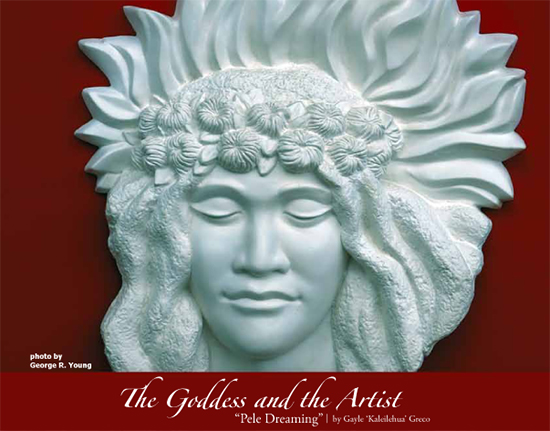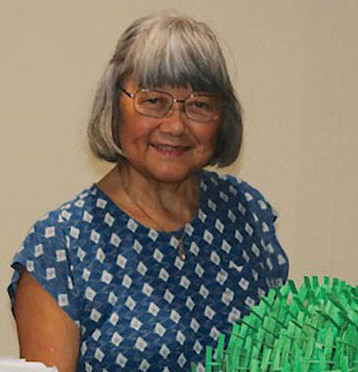
Gilmore Art Inspires Native Plant Renaissance: Jamie Gilmore’s Botanical Portraits Reflect Nature’s Brilliance

By Marya Mann
At 3:15 on a sunny day in Ka‘ū, Jamie Gilmore sits at her table, meticulously painting every petal, flower and sand granule in her watercolor portrait of hinahina, a hardy yet vulnerable native plant indigenous to Hawaiian beaches. Now scarce in the wild, hinahina produces tiny white flowers with a sweet apricot scent, a perfume you can almost sense as Jamie’s painting comes to life.
“Hinahina just kind of creeps along the sand,” says the artist. “I like drawing attention to plants that are taken for granted—the true survivors of this rugged volcanic landscape, the ones who have evolved to be the purest remaining expression of the Hawaiian Islands.
The well-being of native plants and sharing their beauty through art is Jamie’s life work. At the age of 37, she finds magnificence in nature where most people aren’t looking, and she brings their natural, dignified grace into the spotlight.
“On hikes, it was never about reaching the scenic vista for me. It was always about the miniature ferns, colorful lichens and small, beautiful stones along the way.” She would look at the ground, she says, while others were excitedly pointing across giant chasms of space to unreachable views of valleys and mountain ranges.
“I love to observe and recognize the patterns in nature and plants. Like strong people who have lines of character they’ve developed through the survival of hard times, Hawai‘i’s native plants have chosen to put their energy into surviving—not being ostentatiously beautiful in the conventional sense,” she says. “Their beauty lies in their strength and their evolutionary journey.”
Jamie’s love of art and plants goes back to her childhood. She started drawing at the age of two, a result of being an only child in a rural area with no friends her age. In her early 20s, she started gardening in northern California and became enamored with the profusion of rhododendrons and Pacific dogwoods dotting the luxuriant slopes of white-capped Mt. Shasta. Earning a B.A. in Fine Arts from California State University at Chico merged her two loves: nature and painting. Then came a new adventure: she and her husband moved to Hawai‘i Island in 2003 and started building their Ka‘ū cabin by hand, from the ground up.
“When we moved to the island, I was devastated. I didn’t know any of the plants around me. I felt so alone, like oh my God, where is my plant family?”
Learning about native plants helped her to get a feel for Hawai‘i’s extreme conditions and the varied multi-cultural surroundings. Strong, drought-resistant and tenacious, native plants reflect the rough countryside where they grow. Pushed by people, animals and invasive species to choose out-of-the-way spots where they could flourish, Hawaiian endemic and indigenous plants have adapted extraordinary survival skills. They cling to remote cliffs, conserve resources, and maximize every endurance pattern known to botanical life.
Highlighting these “original pioneers of Hawai‘i” in watercolor, Jamie Gilmore is on a quest no less inventive and no less intense. “They came here long before humans ever got here,” says Jamie. “Every plant expresses its own unique geometry, and I love to play with that, use it in my designs,” Jamie says.
These motifs repeat in her signature borders—elegant frames customized for the main subject in the portrait. With her Japanese archival ink pens, round-shaped synthetic brushes (#0, 1, and 2) and French Aquarelle permanent pigment watercolors, she echoes the life-giving shapes inherent in the plant’s organic form. Her stylized art deco and mandala-like edgings remind viewers of the geometric perfection in nature.
‘Ahinahina – Hawaiian Silversword
The journey behind Jamie’s watercolor in dusty shades of purple and frosted green of another native plant began long ago when the first Hawaiian silversword seeds arrived as drift debris on ocean waves or on the wings of a prehistoric bird. ‘Ahinahina found a home between 5 and 10 million years ago on the wind-swept alpine desert of the tallest mountain in the world, Mauna Kea.
Known as the “crown jewel” of Hawai‘i’s native flora, ‘ahinahina evolved in such rugged conditions on the high slopes (6,000–12,000 feet) of only three mountains in the world—Mauna Kea and Mauna Loa on Hawai‘i Island and Haleakalā in Maui—that they had no predators until 300 years ago. Nested in sharp volcanic cinders and nutrient-poor soil, they survived drought, snow, wind, and extreme ultra-violet rays from the sun, but there was no need to develop thorny or toxic protection from animals.
By 1820, thousands of Mauna Kea silverswords had spread rosettes of dagger-shaped leaves, covered with silvery hairs to reflect light and heat, over the amethyst-colored slopes. The Hawaiian word hinahina means “silver” or “gray,” and thus applies to many island plants, but the grand spires of ‘ahinahina were so unique and abundant that cowboys sang songs about the blinding glare of the sun reflecting on their leaves.
In a glorious outpouring of creativity, most silverswords flower only once after growing for 20-50 years. Stored water in their aloe-like leaves is especially vital then; sufficient moisture is needed to support a fast-growing 6- to 9-foot flower stalk, which generates about 600 magenta and yellowish green flowers.
Each of those flowers generates 500 more tiny rosettes, making the blooming silversword spire a beacon of pollination and regeneration.
Poor land-use practices allowed sheep, feral cattle and other alien (non-native) ungulates to browse and nearly wipe out the Hawaiian silversword species. The decimation was barely kept in check by feral dogs until they were eliminated in 1921, leaving ‘ahinahina exposed and in danger of species extinction.
Tourists, up through the 1960s, often broke off silversword leaves to prove they had climbed Hawai‘i’s volcanic mountains and the native Hawaiian yellow-faced bee (Hylaeus), the plant’s primary pollinator, was ravaged by aggressive ants. Although non-native honeybees visit the sunflower-like blooms, they steal pollen rather than move it between plants. This genetic bottle-neck became so life-threatening to the majestic silversword that botanists declared that every Hawaiian silversword seed should be sought, saved, and cultivated.
Working Together—Partnerships for Recovery
The wild population of Mauna Kea silversword at one point dwindled to 32 plants growing outside of Waipahoehoe Gulch; the Mauna Loa silversword declined to 300 individuals at its lowest count.
The Hawaiian Silversword Foundation and the Volcano Rare Plant Facility have teamed up to propagate new silverswords, assuring that out-planted populations have maximum genetic diversity for long-term fitness and survival. Together with efforts by the Hawai‘i Division of Forestry and Wildlife, the U.S. Fish and Wildlife Endangered Species Program and the University of Hawai‘i, an extraordinary cooperative effort is saving and regenerating these plant treasures.
Employees at the 116,000-acre Kahuku Ranch at Hawai‘i Volcanoes National Park have erected a 6-foot fence to protect 700 silverswords from sheep and an amazing 83 percent of new plantings are surviving. In just six short years, a once-dwindling treasure has become a survivor, a testament to how committed people, volunteers and effective agencies can reclaim the island’s botanical heritage.
For their heroic efforts to succeed, the brave hand-pollinators must locate a blooming plant, often rappel over a cliff or climb up a rock face to reach it, and dangle on a rope to collect a vial of the tiny yellow grains from the flower. Then they go in search of a second flowering silversword, which often requires another careful ascent or descent to reach it. These gutsy botanists then use a small brush to delicately paint the pollen on the second plant’s sticky stigma where germination can occur.
Jamie’s brushstrokes may be no less significant in helping endangered and threatened Hawaiian plants to thrive again. “The challenges facing Hawai‘i’s native flora are great,” says the watercolorist. “Many native plants have been eclipsed by the popularity of foreign tropicals like torch gingers, heliconia, and invasive passionflower vines.”
She might sell more of her work if she chose to paint non-native plumeria or bird of paradise because tourists and new residents are attracted to their showy colors. “It’s more important to me to feel like I am honoring the islands in my own unique way,” she affirms. “I will put this goal over commerce always.”
“The process of creating a painting feels a bit like creating an altar to honor an ancestor, an ancestor that has been mostly forgotten,” she says. “While I’m painting, I’m the most myself I can possibly be. I feel like I’m designing a set for a play and the plants are the lead actors.”
The glowing portraits of silversword, sandalwood and the native Hawaiian hibiscus have value far beyond the painting, especially if they contribute to the plant’s survival and renaissance. “What can we offer to the islands? Not the other way around. I would love it if my work swayed someone to choose a native Hawaiian plant over an exotic one next time they were in the nursery. Not all native plants need special attention,” she says. “Some of them are adapted to survive and thrive with very little maintenance, if any.”
In 2005, three of Jamie’s works were accepted into the Honolulu Academy of Arts “Artists of Hawai‘i Exhibition.” Of 300 artists statewide, only 27 were selected. When her original silversword painting was purchased by the Hawaii State Foundation on Culture and the Arts, her commitment to painting Hawaii’s endemic plants was, at that moment, “validated and supported—my life’s purpose realized.”
In her Ka‘ū cabin, she’s still looking in new directions. She adds little dabs of sand-colored paint to the petite hinahina she’s working on. Little pointillist thrusts texture the beach at the bottom of the watercolor. “I want a little bit more deepening of the colors so that the inside comes forward. I’m going to darken the leaves around gradually, getting lighter towards the center. It’s all about layering with watercolors….letting the richness slowly emerge through gradually darker washes.”
Jamie Gilmore’s brush strokes resonate with the geometry of the ancient plants, the brushes used by daring scientific silversword seed-savers, and the exaltation of life in the multi-species effort to regenerate Hawaii’s native flora. Hardy, hard-to-find “true natives,” who have survived on-island longer than anyone, are patient, resilient and steady—traits needed to adapt in the thrall of evolution.
These treasured plants, illuminated by the brushstrokes of the watercolorist, make a picture that tells more than a thousand words: they share nature’s time-tested wisdom.
• Find Jamie on Wednesdays and most Saturdays at the Na‘alehu Farmers Market (weather permitting) and see her work at Elements Gallery in Hawi, North Kohala.
• Other event listings and original work, limited edition giclée reproductions, and greeting cards can be found at her website.
• Purchase Native Hawaiian plants at Amy Greenwell Ethnobotanical Garden, Captain Cook, and Aikane Nursery, North Kohala
• Hawaiian Silverswords are protected by state and federal law. Anyone who takes plant material—seeds, flowers or small plants—from their habitat is subject to heavy fines. Report infractions.
• If you come across a flowering Silversword with seeds ready to fly, contact the Volcano Rare Plant Facility.
Hawaiian, common, and Latin plant names of a few endangered natives:
‘Ahinahina (Hawaiian Silversword): Mauna Kea Argyroxiphium sandwicenses; Mauna Loa Argyroxiphium kauense; and Haleakala Argyroxiphium macrocephalum
Hinahina (Beach Heliotrope): Heliotropium anomalu
‘Iliahi (Hawaiian Sandalwood): Santalum freycinetianum
Ma’o hau hele (State Flower of Hawai‘i, the Hawaiian Hibiscus): Hibiscus brackenridgei


